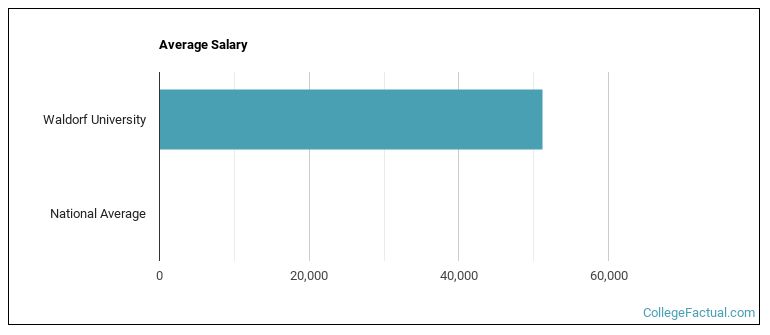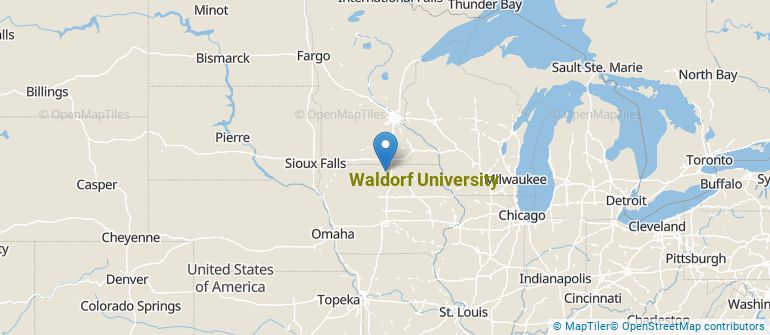 by our College Data Analytics Team
by our College Data Analytics TeamIn its yearly rankings, College Factual analyzes over 2,000 colleges and universities to determine which ones are the best in a variety of categories, such as overall value, quality, diversity, which schools are the best for each major, and much more.
Waldorf University was awarded 26 badges in the 2025 rankings. The highest ranked major at the school is homeland security, law enforcement & firefighting.
Explore the best ranked schools for the programs you are most interested in.
According to College Factual's 2025 analysis, Waldorf is ranked #806 out of 2,152 schools in the nation that were analyzed for overall quality.
Out of the 37 colleges in Iowa, Waldorf is ranked at #14.
Waldorf University has an acceptance rate of 74%, which makes it somewhat selective. Make sure it's not the only school you apply to, even if it's your school of choice. Whether you get in or not will largely depend on how you compare to other applicants.
The student to faculty ratio is often used as a measure to gauge how much access students will have to their professors - the lower the number, the better. At Waldorf University, this rate is 24 to 1, which is high when compared to the national average of 15 to 1.
When estimating how much access students will have to their teachers, some people like to look at what percentage of faculty members are full time. This is because part-time teachers may not have as much time to spend on campus as their full-time counterparts.
The full-time faculty percentage at Waldorf University is 30%. This is lower than the national average of 47%.
The freshmen retention rate tells us what percentage of first-year, full-time students choose to continue on to their sophomore year at a particular school. The rate at Waldorf University is 70%, which is about average when compared to the national rate of 68%.
Students are considered to have graduated on time if they finish their studies within four years. At Waldorf the on-time graduation rate of first-time, full-time students is 46%. That is great when compared to the national average of 33.3%
Find out more about the retention and graduation rates at Waldorf University.
During the 2017-2018 academic year, there were 2,523 undergraduates at Waldorf with 1,578 being full-time and 945 being part-time.
| $0-30 K | $30K-48K | $48-75 | $75-110K | $110K + |
|---|---|---|---|---|
| $17,226 | $17,410 | $16,780 | $20,391 | $21,078 |
The net price is calculated by adding tuition, room, board and other costs and subtracting financial aid.Note that the net price is typically less than the published for a school. For more information on the sticker price of Waldorf, see our tuition and fees and room and board pages.
While almost two-thirds of students nationwide take out loans to pay for college, the percentage may be quite different for the school you plan on attending. At Waldorf, approximately 83% of students took out student loans averaging $6,527 a year. That adds up to $26,108 over four years for those students.

Get more details about the location of Waldorf University.

Contact details for Waldorf are given below.
| Contact Details | |
|---|---|
| Address: | 106 S Sixth St, Forest City, IA 50436-1713 |
| Phone: | 641-585-2450 |
| Website: | www.waldorf.edu/ |
| Most Popular Majors | Bachelor’s Degrees | Average Salary of Graduates |
|---|---|---|
| Business Administration & Management | 184 | NA |
| Quality Control Technology | 141 | $65,908 |
| General Business/Commerce | 103 | $51,954 |
| Homeland Security | 86 | $66,446 |
| General Psychology | 82 | $41,193 |
| Writing Studies | 71 | NA |
| Fire Protection | 71 | $97,731 |
| Health & Medical Administrative Services | 65 | $46,923 |
| Human Resource Management | 56 | $77,897 |
| General English Literature | 37 | NA |
Online courses area a great option for busy, working students as well as for those who have scheduling conflicts and want to study on their own time. As time goes by, expect to see more and more online learning options become available.
In 2022-2023, 2,096 students took at least one online class at Waldorf University. This is an increase from the 1,867 students who took online classes the previous year.
| Year | Took at Least One Online Class | Took All Classes Online |
|---|---|---|
| 2022-2023 | 2,096 | 2,096 |
| 2021-2022 | 1,867 | 1,867 |
| 2020-2021 | 2,343 | 2,343 |
| 2018-2019 | 2,551 | 2,515 |
If you’re considering Waldorf University, here are some more schools you may be interested in knowing more about.
Curious on how these schools stack up against Waldorf? Pit them head to head with College Combat, our free interactive tool that lets you compare college on the features that matter most to you!
Footnotes
*The racial-ethnic minorities count is calculated by taking the total number of students and subtracting white students, international students, and students whose race/ethnicity was unknown. This number is then divided by the total number of students at the school to obtain the racial-ethnic minorities percentage.
References
More about our data sources and methodologies.